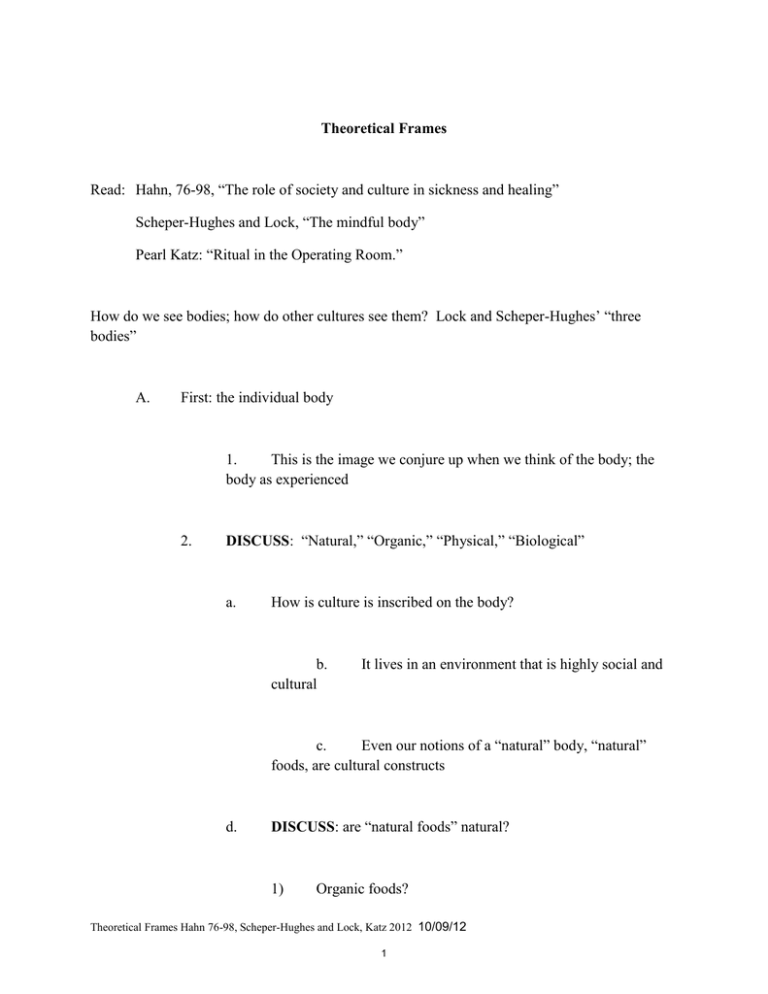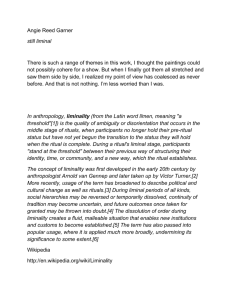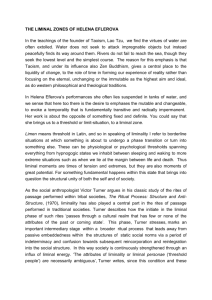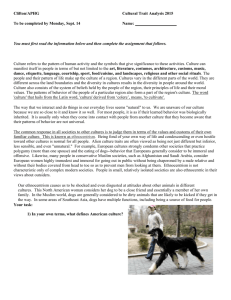Theoretical Frames Scheper-Hughes and Lock, “The mindful body”
advertisement

Theoretical Frames Read: Hahn, 76-98, “The role of society and culture in sickness and healing” Scheper-Hughes and Lock, “The mindful body” Pearl Katz: “Ritual in the Operating Room.” How do we see bodies; how do other cultures see them? Lock and Scheper-Hughes’ “three bodies” A. First: the individual body 1. This is the image we conjure up when we think of the body; the body as experienced 2. DISCUSS: “Natural,” “Organic,” “Physical,” “Biological” a. How is culture is inscribed on the body? b. cultural It lives in an environment that is highly social and c. Even our notions of a “natural” body, “natural” foods, are cultural constructs d. DISCUSS: are “natural foods” natural? 1) Organic foods? Theoretical Frames Hahn 76-98, Scheper-Hughes and Lock, Katz 2012 10/09/12 1 3. The now-familiar Cartesian legacy a. A dichotomy, an opposition that goes back to Aristotle, even though the name refers to the 17th century philosopher Descartes What was Descartes trying to do with his insistence b. on visibility, palpability? 1) Rid medicine of its religio-magical thinking 4. Our need to dichotomize, to think of things as opposites, is pervasive 5. DISCUSS: do we see ourselves as egocentric drives, impulses, wishes and needs that are opposed to the demands of the social and moral order? 6. DISCUSS: do you see culture as something very different from, even opposed to, the individual/body? 7. What is the cultural input to our emotions? 2 8. Example of feral, “cultureless” children: the “wild child” of Aveyron, a region in S. France (19th century) a. They were thought to be “natural” humans, with no cultural overlay b. So by studying them we could find out about “true,” “natural” “core” humanity c. What they in fact were is pathological; what they illustrated is how much human babies and children depend on interacting with other humans in order to develop properly 9. Other cultural systems’ ways of constructing the human body don’t set up binary oppositions in this manner a. E.g., the Chinese pair of yin and yang posit a complementarity, not opposition b. Again, the theme of harmony, balance c. DISCUSS: does the West have anything comparable? 1) The human body as needing balance, harmony? d. Notions of Planet Earth, Mother Earth, the Gaia hypothesis, holism 3 10. How does this body reside in society? a. Some well-known thinkers: b. Freud: saw the individual at war with himself: saw natural, biological drives locking horns with the domesticating requirements of the social and moral order 1) DISCUSS: examples of this viewpoint in the West’s cultural production? (plays, novels) c. Marx: what makes us human is producing our own means of subsistence 1) Again, a concern about what we do with our bodies 2) Labor is seen to humanize, and domesticate nature d. DISCUSS: How do we see our selves as not belonging to the body, as not belonging to nature? 11. We have already discussed how the Western concept of the self is one with far more impervious, clearly demarcated boundaries—more sharply set off from the environment (physical and social)—than is the case in many other cultures 12. Our notion of human development as “naturally” being a process of separation, even estrangement from parents and other family members 4 a. This is definitely not the way many other cultures understand child development We focus on the individual: human rights are b. conceptualized in terms of individual rights c. Whereas, as Scheper-Hughes and Lock point out, the tensions in Japan are between the state and the family, not the individual and state or the individual and family d. In Japan, one reason for not telling someone he/she is dying is that the death is a family matter, not something the individual is going through 1) So why should the dying person decide how it should proceed? 13. The permeable self a. In societies lacking a highly individualized or articulated conception of the body-self 1) Sickness is often explained or attributed to malevolent social relations or the breaking of social and moral codes b. sometimes In healing, too, the patient is almost inconsequential 5 c. Dissociation and possession (going into trance) In general, for us, the self needs to be present d. (except when sleeping), or something’s wrong B. e. DISCUSS: Hypnosis f. DISCUSS: exceptions? Second: the social and cultural body 1. The notion of “natural symbols” a. Mauss, a famous French anthropologist 1) “The body is the first and most natural tool of man” b. How do we use our bodies to understand and describe our world? 2. Different cultures utilize images of the body and its parts to represent other things a. Bowels, liver, backbone, blood 6 b. Reproduction is a very powerful, widely appropriated natural symbol 1) DISCUSS: Birth1 a) Examples in the West? b) “Ye must be born again” c) Find the birth imagery in Christian baptism d) For starters, godparents 2) Initiates in many societies at certain stages of the ritual are treated like newborns in all kinds of clever ways 3. A “natural symbols” analysis can go beyond the body, arguing that the material world is the source for many meanings, metaphors a. DISCUSS: why the color red “naturally” has such pronounced symbolic importance cross-culturally 1) Arguments made in the literature: 1 See, for example, Warren Shapiro and Uli Linke, 1996, Denying Biology: Essays on Gender and PseudoProcreation. University Presses of America. 7 2) #1: blood (the body as “natural symbol”) 3) #2: the color red occurs infrequently (“natural symbol” derived from scarcity in the environment) 4) visible spectrum #3: optics—red lies at one end of the a) This last explanation is the reverse of the “natural symbol” explanation b) Here it’s the physiology of the body that’s seen to determine the phenomenon 4. The social and cultural body: the reverse: how we construct our bodies utilizing society and culture a. DISCUSS: blood 1) Why is menstrual blood so evocative and assigned so much meaning? 2) In many places it’s seen as dangerous, pollution 3) Where I did fieldwork in the Northwest Amazon, among Tukanoans, menstrual blood is seen as a source of relative immortality for women 8 4) Like snakes and insects who shed their skins periodically, Tukanoan women are seen as much healthier because they shed an inner lining in the form of blood each month 5) In several societies men ritually imitate female menstruation and other reproductive processes b. DISCUSS: the corpse 1) Think of all the reasons corpses are thought of as either dangerous or in need of control, elaboration 2) #1: Sources of infection (our explanation) 3) our group die out? #2: Seeing a corpse is scary—will a) We’re reminded that we will die someday 4) #3: A corpse is liminal: betwixt and between (see below) 5) DISCUSS: why, do you think, do some societies practice ritual cannibalism? 9 6) DISCUSS: what does our treatment of corpses tell us about ourselves? 5. So, the body can serve as a source for meanings or vice versa 6. The body as liminal a. “Betwixt and between” phenomena are often seen as negative; sometimes positive b. highlighted c. Very frequently they are culturally elaborated, The corpse: a body without its owner is liminal d. Parts of the body that were of the body but are now detached are liminal 1) Blood, milk, tears, semen, urine, sweat, excreta (feces), hair C. The body politic 1. A difficult concept to grasp: be sure you understand it 2. Ways in which bodies are regulated? 10 3. Reproduction a. The example mentioned in an earlier lecture 1) A California judge required the insertion of the contraceptive Norplant as an option in place of a jail sentence for a crack-addicted mother of 6 who was neglecting the ones she already had b. will watch 1) 4. I mentioned a video, “The Lynchburg Story” we About institutionalized sterilization in Virginia Other kinds of unruly, unregulated behavior needing regulation a. A search for an “anti-violence” drug following urban unrest in the mid 1960s b. Cambridge police saying pepper spray is less effective on Hispanic populations because they eat lots of hot chile peppers—so the police apply a greater quantity 1) Here we have ethnicity and class stratification being “read” onto brown bodies c. Society’s regulation of appearance? 11 1) The correct body for the nation: both sexes: lean, strong, androgenous, physically “fit” form through which the core cultural values of autonomy, toughness, competitiveness, youth, and self-control are readily manifest The notion that regulation of the body will produce d. good citizens 1) The ideology of Boy Scouts: earlier and today 2) National Socialism (Nazis): published lots of literature on the importance of building correct bodies (and minds) 5. The self-regulated body a. Proper bodies, like health itself, are achieved b. Contradictions? 1) Fitness may suggest self- control 2) Yet such attention to the body can also suggest: 12 a) Self- indulgence b) Pleasure-seeking consumers, especially women c) Or liberation from societal constraints—example of the video “Pumping Iron II” about female body builders 13 MIT OpenCourseWare http://ocw.mit.edu 21A.215 Disease and Health: Culture, Society, and Ethics Spring 2012 For information about citing these materials or our Terms of Use, visit: http://ocw.mit.edu/terms.






